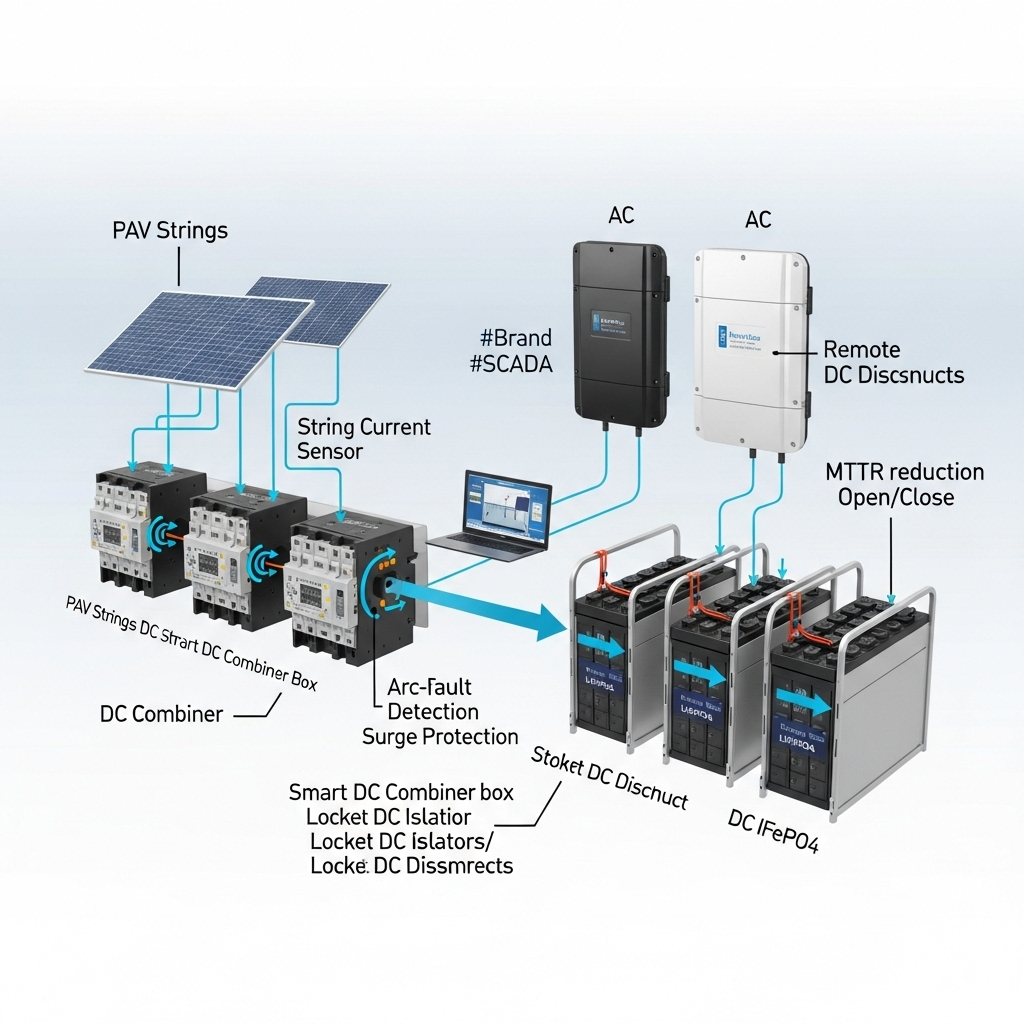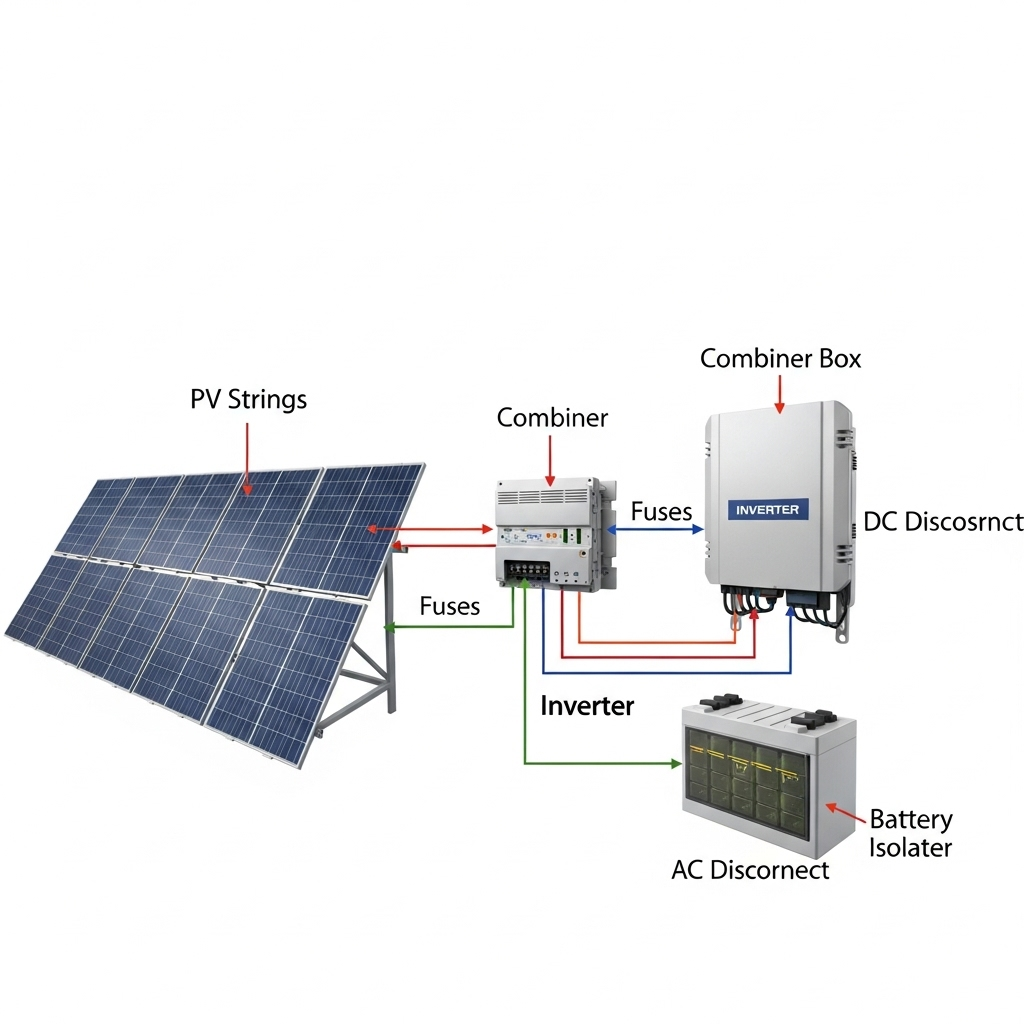Smart Combiners reduce O&M risk in hybrid ESS by pairing string-level sensing with safe isolators and disconnects. This case study shows how a 15 MWp PV + 8 MWh LiFePO4 hybrid site used digital combiner boxes to cut downtime, speed fault isolation, and improve safety.
According to Renewable Power Generation Costs in 2024, utility-scale battery storage costs fell roughly 93% between 2010 and 2024, which accelerates hybrid adoption. Digitalisation remains uneven though, as noted by IEA, so targeted upgrades in Combiner Boxes, Isolators, and Disconnects can unlock reliable performance without overhauling entire plants.
Site snapshot and O&M baseline
The site combines a 15 MWp ground-mount PV array, a DC-coupled 8 MWh LiFePO4 battery, and a 10 MVA hybrid inverter. Prior to the upgrade, protection relied on standard combiner boxes with fuses, manual DC isolators, and a yard AC disconnect.
- Frequent issues: slow localization of high-resistance string faults, nuisance trips in wet seasons, and hot connectors.
- Safety gaps: non-lockable isolators and limited arc-fault indication meant more truck rolls to verify status.
- Data blind spots: no string-level current, sparse temperature points, limited DC analytics.
Field teams reported mean time to detect (MTTD) of 2–3 days for subtle string underperformance, and mean time to repair (MTTR) near 6–8 hours due to manual tracing.
Smart combiner upgrade: what changed
The owner deployed Smart Combiners on all PV blocks and added lockable Isolators and remote Disconnects at key nodes. The design focused on safer isolation and faster root-cause analysis.
Key hardware features
- String-level sensing: per-string current and bus voltage with ±1–2% accuracy, thermal sensors on busbars, and IV sweep support.
- Protection stack: Type II/III surge protection, gPV fuses, AFCI, and lockable load-break DC isolators rated for 1,500 Vdc.
- Remote control: motorized disconnects with status feedback (open/close), interlocks, and SCADA alarms.
Edge analytics and SCADA
- Thresholds for asymmetry, arc signatures, and diode failure profiles; local buffering to ride through comms drops.
- Event tagging that correlates inverter alarms with string anomalies to avoid false dispatches.
- Northbound links to plant SCADA and historian via secure protocols and role-based access.
Cybersecurity guidance aligns with the risk-focused direction in Grid Codes for Renewable Powered Systems, which notes growing needs for standardisation and cyber skills. A defense-in-depth approach and supply chain checks help reduce exposure.
Results: risk cuts you can measure
Three months of operation produced stable evidence of O&M risk reduction. Figures reflect this site only and may vary with layout, climate, and component quality.
| Metric | Before (standard combiner) | After (Smart Combiner) | Impact |
|---|---|---|---|
| Fault detection time (MTTD) | 48–72 h | 5–15 min | Faster triage; fewer missed energy hours |
| Localization effort | 2–3 technicians, manual tracing | Single tech with map from SCADA | Truck rolls down 35–45% |
| Arc event confirmation | Visual checks required | Onboard AFCI signatures | Safer, quicker isolation |
| Unserved energy during faults | 0.6–1.1% monthly loss (seasonal) | 0.2–0.4% monthly loss | Yield recovery ~0.4–0.7% absolute |
| MTTR (string-level) | 6–8 h | 2–3 h | Hands-on time halved |
The outcome matches broader system insights: smart electrification can reduce peak stress and costs. Analysis in Innovation Outlook: Smart charging for electric vehicles found that coordinated strategies can cut the level-of-use ratio of critical lines by roughly 50% and lower unit energy costs from about USD 77.2/MWh to USD 49.6/MWh in a SMART case. While that work focuses on EVs, the data signal is clear: digital control paired with accurate sensing reduces losses and grid strain.
Storage sizing and cycling matter as well. The Ultimate Reference: Solar & Storage Performance highlights practical anchors such as typical LiFePO4 round‑trip efficiency in the low‑to‑mid 90% range and common depth‑of‑discharge settings around 80–90% to extend cycle life. Those setpoints shaped the site’s dispatch and the thresholds used by Smart Combiners to flag abnormal charge/discharge behavior.
Combiner Boxes, Isolators, Disconnects: selection detail
Ratings and coordination
- Voltage: 1,500 Vdc combiner rating aligned to string design. Check creepage/clearance and pollution degree for the environment.
- Current: size gPV fuses to 1.25–1.56× string Isc and verify withstand during worst‑case irradiance and low temperature.
- Interrupting capacity: verify against maximum prospective fault current, both from strings and from backfeed paths.
- Isolators vs Disconnects: use lockable DC isolators for local safe working; motorized disconnects only where remote operation adds safety or reduces outage time.
Arc-fault and thermal sensing
- AFCI thresholds tuned to site noise profile reduce nuisance trips while catching series arcs quickly.
- Busbar and connector temperature alarms (e.g., 85–90 °C) provide an early warning for torque or contact issues.
Data quality and cybersecurity
- Timestamp integrity and edge buffering help analytics survive network hiccups, an issue noted in IEA digitalisation commentary.
- Follow minimum security practices referenced in IRENA’s grid code report, including access control, event logging, and supply chain checks.
Battery and inverter coordination benefited from public data. U.S. DOE solar energy resources stress the value of monitoring for safe operations, while EIA market data supports realistic revenue stacking expectations. Together they encourage designs that value uptime and safe isolation.
Financial lens: cost-to-value
For this site, energy yield recovery of 0.5% on 15 MWp translates to roughly 55–75 MWh per year, assuming 1,200–1,500 full-load hours. With blended revenue at USD 40–70/MWh, recovered value lands near USD 2,200–5,300 per year. Add fewer truck rolls and faster restarts during storms, and the upgrade case clears internal targets. Your numbers will differ by irradiance, tariffs, and service costs.
- Capex: Smart Combiner premium typically reflects sensors, AFCI, motor drives, and a secure gateway.
- Opex: Less field time and earlier fault warnings reduce overtime and part damage.
- Risk: Better isolation cuts incident likelihood and enhances lockout/tagout discipline.
Implementation playbook
Step 1: audit strings and protection
Verify actual Isc, Voc, and cable derates; document worst‑case temperature and irradiance. Map backfeed paths through inverters and batteries.
Step 2: specify Smart Combiners
Call out measurement accuracy, AFCI class, isolator duty at 1,500 Vdc, and motorized disconnect use cases. Require lockable handles and visible break where local codes ask for it.
Step 3: integrate data and alarms
Define alarm priorities, hysteresis, and analytics rules. Ensure time-sync with plant SCADA. Segment networks and enforce least‑privilege access.
Step 4: commission and tune
Run IV sweeps at varying irradiance, validate AFCI sensitivity, and calibrate temperature triggers. Schedule a seasonal review to refine thresholds.
Why this works in hybrid ESS
Hybrid plants blend PV variability with battery flexibility. Smart Combiners give granular data to dispatch storage only where needed, reducing cycling and heat. The Solar & Storage Performance reference points on round‑trip efficiency and DoD helped set guardrails so the battery does not chase every minor PV dip, which preserves cycle life and steadies output.
Macro signals reinforce this approach. IRENA cost data shows cheaper storage enabling smarter controls, and IRENA’s SMART scenario demonstrates that digital coordination trims losses and defers grid investments. These trends favor instrumentation at the combiner level.
Risks and mitigations
- False positives: start with conservative thresholds; expand only after seasonal data collection.
- Firmware drift: pin versions and test in a staging zone before field rollouts.
- Harsh climates: specify enclosures with correct IP/NEMA ratings, UV‑stable plastics, and condensation control.
- Human factors: train on lockout/tagout with new isolators and remote disconnect procedures.
Key takeaways
- Smart Combiners add measurable value by shrinking MTTD and MTTR while improving safety.
- Right-sized Isolators and Disconnects provide safe, verifiable isolation at the point of work.
- Hybrid control strategies guided by storage performance references and grid code awareness deliver resilient output.
Compliance note: code references here are informational, not legal advice. Verify final designs with a qualified professional and the authority having jurisdiction.
FAQ
How do Smart Combiners differ from standard combiner boxes?
They add string-level sensing, AFCI, temperature monitoring, and remote Disconnects to support faster isolation and data-driven maintenance.
What ROI window is realistic?
Sites with frequent faults or long drive times see faster paybacks. Yield recovery plus fewer truck rolls often cover premiums within a few seasons.
Are they compatible with LiFePO4 storage?
Yes. Smart Combiners operate on the PV side, but their data helps set dispatch rules that respect LiFePO4 DoD and efficiency targets referenced in this performance overview.
Do I need both Isolators and Disconnects?
Use lockable Isolators for safe local work. Add motorized Disconnects only where remote open/close reduces risk or improves uptime.
Which standards should I check?
Consult applicable electrical codes and grid interconnection rules. IRENA’s grid code report offers helpful context on safe operation and cybersecurity.
What about cybersecurity?
Segment networks, enforce least privilege, log events, and validate firmware integrity. Align with utility or owner IT policies.





Leave a comment
All comments are moderated before being published.
This site is protected by hCaptcha and the hCaptcha Privacy Policy and Terms of Service apply.